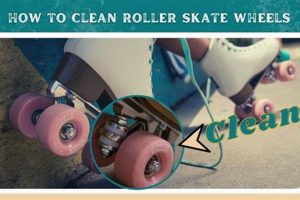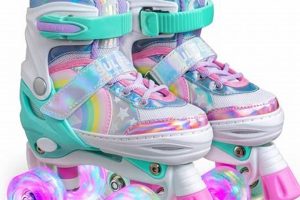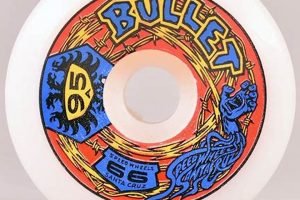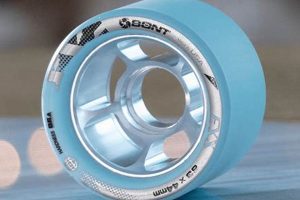Inline skates featuring a configuration of three wheels, as opposed to the more traditional four, represent a distinct evolution in skating technology. These skates utilize larger wheel diameters, typically ranging from 90mm to 125mm, optimizing performance characteristics for speed and maneuverability.
The configuration offers several advantages. The larger wheels facilitate enhanced rolling efficiency, contributing to increased speed and smoother rides, particularly on uneven surfaces. The reduced number of wheels can result in a lighter skate, potentially improving agility and responsiveness. Historically, this design emerged as skaters sought to bridge the gap between the speed of inline skates and the enhanced maneuverability offered by ice skates. It is a design that has been gaining popularity among fitness skaters and those seeking enhanced performance.
The design considerations, performance attributes, and suitability for various skating disciplines warrant closer examination. Subsequent sections will explore topics such as the wheel size impact, frame material selection, and the target demographics for this skating configuration.
Expert Guidance on Three-Wheel Inline Skates
Maximizing the potential of inline skates with three-wheel configurations requires careful consideration of technique and equipment. The following guidance facilitates optimal performance and ensures skater safety.
Tip 1: Gradual Adaptation: New users should acclimate to the distinct handling characteristics of three-wheel skates through controlled practice sessions. Initiate skating on smooth, level surfaces, focusing on balance and stride technique.
Tip 2: Wheel Hardness Selection: Wheel durometer, measured on the A scale, significantly impacts grip and rolling resistance. Harder wheels (e.g., 85A) offer lower rolling resistance, ideal for speed, while softer wheels (e.g., 82A) provide enhanced grip, suitable for varied surfaces and tighter turns.
Tip 3: Frame Alignment Adjustment: Frame alignment relative to the boot can be adjusted to optimize skating efficiency and address pronation or supination. Minor adjustments can significantly enhance comfort and reduce fatigue during extended skating sessions.
Tip 4: Bearing Maintenance Protocol: Regular cleaning and lubrication of wheel bearings are essential for maintaining optimal rolling efficiency. Remove bearings periodically and use a solvent-based cleaner to eliminate dirt and debris. Re-lubricate with a synthetic bearing lubricant.
Tip 5: Protective Gear Compliance: Prioritize safety through consistent use of appropriate protective gear. This includes a properly fitted helmet, wrist guards, elbow pads, and knee pads. Inspect gear regularly for wear and tear, replacing damaged components as needed.
Tip 6: Stride Optimization: Efficient skating relies on a balanced and powerful stride. Focus on maintaining a low center of gravity, extending the stride fully, and engaging core muscles for stability. Avoid excessive upper body movement.
Tip 7: Braking Technique Proficiency: Master effective braking techniques specific to inline skates. The heel brake, standard on many models, requires consistent downward pressure. Practice emergency stopping maneuvers in a controlled environment.
These guidelines highlight the importance of adapting to the unique characteristics of three-wheel inline skates, emphasizing safety, maintenance, and technique refinement for enhanced performance and enjoyment.
The following sections will further explore specific aspects of equipment selection, advanced skating techniques, and training methodologies applicable to this specialized form of inline skating.
1. Maneuverability
The implementation of three-wheel configurations in inline skates directly affects maneuverability characteristics. A primary contributor to this effect is the reduced wheelbase, the distance between the front and rear axles. This shorter wheelbase, relative to traditional four-wheel setups, enables quicker turning radii and enhanced agility. This becomes particularly evident in congested environments, such as urban skating or slalom courses, where the ability to execute rapid directional changes is crucial.
The impact of wheel size further accentuates this maneuverability advantage. While larger wheels generally promote speed, their combination with a three-wheel design offers a balanced compromise. Skaters can maintain reasonable speed while benefitting from the heightened responsiveness. For instance, a skater navigating a crowded pedestrian walkway can more easily avoid obstacles with a shorter-wheelbase, three-wheel skate compared to a longer four-wheel model. The ability to quickly adjust trajectory is a distinct benefit.
The connection between maneuverability and three-wheel design represents a design trade-off. While top-end speed may be slightly sacrificed compared to some four-wheel setups, the gains in agility and control are significant for specific applications. Understanding this trade-off is crucial for skaters selecting equipment based on their intended use and skill level, as the capacity for quick reactions and tight turns can dramatically impact the overall skating experience and safety.
2. Rolling Efficiency
Rolling efficiency, the minimization of energy loss due to friction and deformation as a wheel rotates, is a crucial performance parameter in skating. In inline skates featuring a three-wheel configuration, rolling efficiency is primarily influenced by wheel size and bearing quality. Larger wheels, commonly found in these designs, exhibit an increased contact patch with the skating surface. This expanded contact area, while seemingly counterintuitive, distributes the skater’s weight over a greater area, reducing pressure and deformation of the wheel material. The result is lower rolling resistance and improved energy transfer, allowing the skater to maintain speed with less effort. An example is a skater covering long distances; skates with greater rolling efficiency translate to less fatigue over time.
The selection of high-precision bearings further amplifies the impact on rolling efficiency. Bearings characterized by tighter tolerances and superior materials minimize internal friction. This reduction in friction directly translates to smoother wheel rotation and a corresponding increase in the distance covered per push. Consider a scenario where two skaters of equal ability are using inline skates; the skater with superior bearings will experience a noticeable advantage in maintaining momentum and reducing the frequency of required pushes. Moreover, proper bearing maintenance, including regular cleaning and lubrication, sustains optimal rolling efficiency over the lifespan of the skates.
In summary, the design of three-wheel skates, particularly the incorporation of larger wheels and the potential for utilizing high-grade bearings, directly contributes to enhanced rolling efficiency. This characteristic is a key differentiator, offering skaters the potential for increased speed, reduced fatigue, and an overall improvement in skating performance. Maximizing rolling efficiency necessitates careful consideration of wheel material, bearing selection, and consistent maintenance practices. This understanding allows skaters to fully leverage the advantages inherent in three-wheel inline skate designs, realizing improved speed and endurance.
3. Frame Rigidity
Frame rigidity, in the context of inline skates with a three-wheel configuration, directly influences power transfer and stability. A rigid frame minimizes energy loss during each stride by resisting deformation under load. This ensures that a greater proportion of the skater’s effort is translated into forward momentum, rather than being absorbed by frame flex. This is particularly critical in three-wheel designs, where the larger wheels generate greater leverage forces on the frame. A lack of frame rigidity results in a sluggish feel and reduced efficiency. For example, a skater performing a speed drill on a track would experience significant energy loss with a flexible frame, resulting in slower lap times and increased fatigue.
The material composition and structural design of the frame dictate its rigidity. Frames constructed from high-grade aluminum alloys, often featuring reinforced cross-sections or strategically placed ribs, exhibit superior resistance to bending and twisting. Furthermore, the frame’s connection points to the boot and wheel axles are crucial areas for maintaining stiffness. Loose or poorly designed connections contribute to frame flex, negating the benefits of otherwise rigid materials. Consider a skater executing a sharp turn; a rigid frame maintains consistent wheel alignment, providing predictable handling and enhanced control, while a flexible frame can lead to unpredictable steering and a loss of stability.
In conclusion, frame rigidity is a fundamental attribute of three-wheel inline skates, directly affecting energy transfer, stability, and overall skating performance. Insufficient rigidity compromises efficiency and control, while a well-designed, rigid frame maximizes power transmission and provides a responsive skating experience. Choosing skates with a focus on frame materials, design, and connection integrity is paramount for skaters seeking optimal performance. The interrelationship of these elements underscores the importance of considering frame rigidity as a critical factor in the selection and use of three-wheel inline skates.
4. Bearing Precision
Bearing precision, a measure of manufacturing accuracy and tolerance, plays a critical role in the performance of inline skates, particularly those utilizing a three-wheel configuration. Its influence extends to rolling efficiency, speed, and overall lifespan of the skates. The precise execution of bearing design and manufacturing directly affects the skater’s experience.
- ABEC Rating Impact
The Annular Bearing Engineering Committee (ABEC) rating system quantifies bearing precision. Higher ABEC ratings (e.g., ABEC 7, ABEC 9) indicate tighter tolerances, resulting in reduced friction and improved rolling speed. Inline skates with three-wheel arrangements benefit significantly from high ABEC-rated bearings because the larger wheels are more sensitive to bearing imperfections. An improperly manufactured bearing in a 110mm or 125mm wheel will cause noticeable vibration and reduced efficiency, negating some of the advantages of the three-wheel design. Conversely, lower ABEC ratings, while less costly, may compromise performance.
- Material Composition
Bearing material impacts precision retention and longevity. Chrome steel is a common material, offering a balance of hardness and corrosion resistance. However, ceramic bearings, although more expensive, exhibit superior hardness, lower friction, and reduced heat generation. The heat resistance is crucial in skates where higher speeds can cause traditional bearings to bind. In three-wheel skates, where skaters often achieve higher speeds due to the larger wheels, ceramic or high-grade steel bearings can offer tangible performance improvements and extended service life, particularly under demanding conditions.
- Lubrication Effects
The type and quality of lubricant used within the bearings significantly influence their precision and performance. High-viscosity lubricants can increase drag, negating the benefits of tight tolerances. Conversely, low-viscosity synthetic lubricants minimize friction and maintain consistent performance across a range of temperatures. The correct lubricant can preserve the precision engineered into the bearing. In three-wheel skates used for speed or distance, a lubricant optimized for low friction is essential to maximize rolling efficiency and minimize energy expenditure.
- Maintenance Protocol
Consistent maintenance is crucial for preserving bearing precision. The accumulation of dirt, debris, and moisture can degrade bearing surfaces, increasing friction and reducing performance. Regular cleaning and re-lubrication are essential, particularly after skating in adverse conditions. Neglecting maintenance will shorten the lifespan of even the highest-precision bearings. For example, a skater who consistently skates in wet conditions without cleaning and lubricating the bearings will experience a rapid decline in bearing performance, regardless of the initial ABEC rating.
The interaction between bearing precision and the performance characteristics of three-wheel inline skates underscores the importance of selecting high-quality components and adhering to diligent maintenance practices. The larger wheels and potential for higher speeds amplify the impact of bearing imperfections, making precision a critical factor in maximizing performance, extending equipment lifespan, and ensuring a smooth skating experience. Skaters should consider these factors when purchasing and maintaining their equipment to fully realize the advantages of the three-wheel design.
5. Wheel Diameter
Wheel diameter is a fundamental characteristic of three-wheel inline skates, exerting a significant influence on speed, maneuverability, and vibration absorption. Larger wheel diameters, typically ranging from 90mm to 125mm in this configuration, inherently offer increased rolling speed due to a reduced angle of attack and lower rolling resistance. This characteristic is particularly beneficial for fitness skating and long-distance skating where sustained speed is a priority. However, the increased wheel size necessitates a taller frame, potentially raising the skater’s center of gravity and impacting stability. For example, a skater transitioning from a four-wheel 80mm setup to a three-wheel 110mm setup will experience a noticeable increase in speed, but may initially find the taller stance less stable during tight turns.
The relationship between wheel diameter and maneuverability in three-wheel skates presents a trade-off. While larger wheels enhance speed, they can also reduce agility compared to smaller-wheeled setups. However, the three-wheel design compensates for this to some extent by shortening the wheelbase, allowing for quicker turns than equivalent four-wheel configurations with the same wheel size. The wheel diameter also affects the skate’s ability to absorb vibrations from uneven surfaces. Larger wheels bridge gaps and imperfections more effectively, providing a smoother ride. For instance, a skater on rough asphalt would experience significantly less vibration with 125mm wheels than with 90mm wheels.
In conclusion, the wheel diameter selection for three-wheel inline skates involves a careful balancing act. Larger wheels offer speed and vibration absorption benefits, while smaller wheels prioritize maneuverability. The ideal choice depends on the skater’s intended use, skill level, and the typical skating environment. Understanding the interplay between wheel diameter, frame design, and skating technique is crucial for optimizing performance and comfort. The practical significance of this understanding lies in the ability to select equipment that aligns with specific skating goals, maximizing both enjoyment and efficiency.
6. Ankle Support
Ankle support is a critical design element in inline skates, and its importance is amplified in three-wheel configurations. The heightened wheel size, typically ranging from 90mm to 125mm, inherent in these skates shifts the skater’s center of gravity, increasing the demand on ankle stability. Inadequate ankle support can lead to instability, reduced power transfer, and a heightened risk of injury. The cause and effect are direct: insufficient support results in ankle pronation or supination, compromising skating efficiency and potentially causing sprains or strains. For instance, a skater attempting a speed maneuver with insufficient ankle support may find their ankle rolling inward, leading to a loss of control and potential fall.
The construction of the boot, specifically the cuff, is paramount in providing adequate ankle support. A rigid cuff, often made from reinforced polymers or carbon fiber, restricts lateral movement and maintains proper ankle alignment. Furthermore, the lacing system and power straps contribute to securing the foot within the boot, enhancing stability. In contrast, a soft or flexible cuff offers limited support, particularly during aggressive skating or high-speed turns. The practical significance of proper ankle support is evident in the skater’s ability to maintain balance, control, and efficient power transfer. A skater with well-supported ankles can execute precise movements and sustain longer skating sessions with reduced fatigue. For example, inline speed skaters rely on rigid ankle support to maintain proper form and maximize energy transfer during each stride. Similarly, fitness skaters benefit from enhanced stability, allowing them to navigate varied terrain with confidence.
In summary, ankle support is an indispensable component of three-wheel inline skates. Its direct impact on stability, power transfer, and injury prevention cannot be overstated. The challenges associated with maintaining adequate support while optimizing comfort require careful consideration in boot design and material selection. By prioritizing robust ankle support, skaters can fully leverage the performance benefits of three-wheel configurations while mitigating the risks associated with instability. This understanding is essential for both skaters and manufacturers to ensure optimal equipment selection and safe skating practices. The interconnection between the skates and the skater is very important.
7. Braking System
The braking system on inline skates, particularly those utilizing a three-wheel configuration, is a critical safety component due to the increased speeds attainable with larger wheels. Three-wheel skates, often designed for speed and distance, require effective braking mechanisms to ensure controlled deceleration and prevent accidents. The most common braking system is a heel brake, typically mounted on the rear of one skate. This system relies on the skater applying pressure to the brake pad against the ground. The effectiveness of this system is paramount, given the potential for higher velocities associated with the larger wheels of three-wheel skates.
Consider the consequences of a malfunctioning or inadequate braking system. A skater descending a slope on three-wheel skates may encounter an obstruction requiring immediate stopping. Without a reliable braking system, a collision is highly probable. Another design factor affecting the braking is the brake’s placement relative to the larger wheels. In order to provide an effective braking mechanism, the pads need to be adjusted correctly for the skates wheels. If the alignment is wrong, it will be hard to effectively slow down or stop. Braking system technologies are continuously being improved.
The connection between braking systems and three-wheel skates highlights the necessity for regular maintenance and inspection. Brake pads wear down over time and require replacement to maintain optimal performance. Furthermore, skaters must develop proficiency in braking techniques to effectively control their speed and ensure safe skating practices. The reliance on the braking system is a crucial element in the overall safety profile of three-wheel inline skates. This profile balances the inherent performance advantages of a three-wheel design with a skater’s capacity for controlled deceleration.
Frequently Asked Questions About 3 Wheel Skates
The following section addresses common inquiries regarding inline skates utilizing a three-wheel configuration. The information provided aims to clarify design considerations, performance characteristics, and appropriate usage scenarios for these skates.
Question 1: What are the primary advantages of “3 wheel skates” compared to traditional four-wheel inline skates?
The primary advantages include enhanced rolling efficiency due to larger wheel diameters, increased maneuverability stemming from a shorter wheelbase, and potentially lighter overall skate weight. These factors contribute to increased speed, agility, and reduced skater fatigue.
Question 2: Are “3 wheel skates” suitable for beginner skaters?
While not inherently unsuitable, beginner skaters may find the increased height and potential instability of “3 wheel skates” challenging. A solid foundation in basic skating skills on traditional four-wheel skates is recommended before transitioning to a three-wheel configuration.
Question 3: What is the typical wheel size range for “3 wheel skates”?
The wheel size range typically spans from 90mm to 125mm. The specific size selection depends on the intended skating discipline, skater skill level, and desired balance between speed and maneuverability.
Question 4: Do “3 wheel skates” require specialized maintenance procedures?
While the core maintenance procedures remain similar to those for four-wheel skates (bearing cleaning, lubrication, wheel rotation), “3 wheel skates” may require more frequent attention due to the increased stress on components resulting from larger wheels and higher speeds.
Question 5: What types of skating are best suited for “3 wheel skates”?
“3 wheel skates” are particularly well-suited for fitness skating, long-distance skating, and urban skating, where the combination of speed, maneuverability, and vibration absorption is advantageous.
Question 6: Are replacement parts readily available for “3 wheel skates”?
Replacement parts, such as wheels, bearings, and frames, are generally available from reputable skate retailers and online vendors. However, compatibility issues may arise depending on the specific skate model and manufacturer.
These questions and answers provide a basic understanding of three-wheel inline skates. Careful consideration of these factors is essential for making informed decisions regarding equipment selection and maintenance.
The subsequent section will explore the historical development and future trends in three-wheel inline skate technology.
Conclusion
The preceding analysis of “3 wheel skates” has explored the design considerations, performance attributes, and practical applications of this specialized form of inline skating. The examination encompassed key elements, including maneuverability, rolling efficiency, frame rigidity, bearing precision, wheel diameter, ankle support, and braking systems. Each of these factors contributes to the overall performance and suitability of three-wheel skates for various skating disciplines.
The continued evolution of skating technology is certain. Ongoing refinements in materials, design, and manufacturing processes will further optimize the capabilities of “3 wheel skates,” potentially broadening their appeal and expanding their application within the broader skating community. A comprehensive understanding of these factors will allow the skater to perform properly while making the correct assessment for their equipment. The future outlook of three-wheel skates is only looking up from here.







